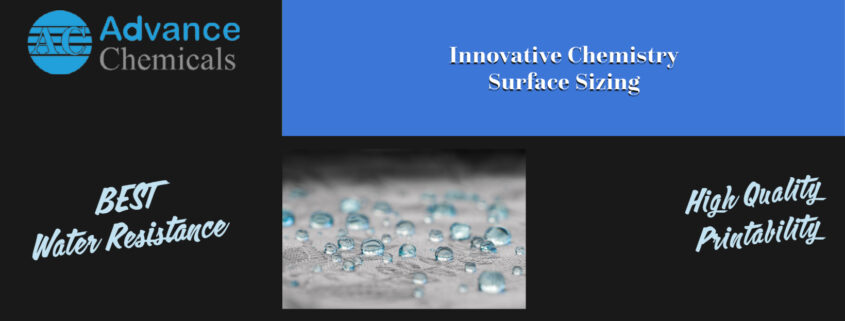Importance of Sizing Agents for Paper Making
Introduction
The papermaking process is highly cost-sensitive and the market is extremely competitive. Specialty chemicals have been developed and applied in to assure an efficient process and meet specific end-use paper requirements.
Paper can be classified according to different criteria, either by weight, color or raw material source. Here we talk about woodfree paper, which is a paper made from chemical pulp, without lignin. With woodfree paper, the final performance depends on the quality of the fibrous matrix and the properties of the surface. The surface characteristics are controlled by surface treatments which aim to give specific qualities to the paper, according to its purpose.
Surface treatments are divided into two types:
- Mechanical, like calendaring, or
- Chemicals such as coating and surface sizing.
Calendaring and surface sizing are the treatments used while the coating is more common in magazine paper or photographic paper.
Why talk about sizing?
Existing studies on surface sizing focus on evaluating the surface quality of paper, after the application of different solutions, through surface characterization techniques such as contact angle measurement or inverse gas chromatography.
The lack of works exploring surface sizing in a more industrial context contributes to the importance and applicability of the present study. The complexity of the paper structure and the presence of various components make this system quite complex. Thus, to establish a possible process optimization and, consequently, a final improvement of paper characteristics, it is essential to understand the interactions between the various components present in this stage of production.
The Process
For surface sizing, a solution composed mainly of starch is applied to the surface of the paper sheet.
Regarding technology, film size press is the most used, in which a film of the solution is transported and applied to the paper surface by the applicator rollers. This technology allows an independent application of the solution to each side of the paper. Usually, solids content, viscosity, and temperature are the process control parameters. The penetration of the solution into the paper structure and its uniform surface often determines the printing quality.
The behavior of a liquid on a surface is crucial for homogeneous film formation processes, where properties such as contact angle and surface tension play an important role. Thus, the present work intends to give a deeper understanding of the interactions between the surface sizing solution and the paper surface. More specifically, it aims to measure the contact angle and the surface tension of surface sizing solutions and to relate these properties to starch content and temperature.
What is Surface Sizing?
Surface sizing is a surface treatment whose main objective is to increase the bond between the fibers by filling the pores with a solution composed mainly of starch. This treatment is used to increase the surface resistance, stiffness, and printability, and to control the hydrophilic character of the fibers.
The surface sizing solution is composed typically of starch, sizing agent, optical brightening agents (OBAs), salt, and defoamers.
Starch is the main component of the solution and it acts as a binder to connect vessel segments and loose fibers at the surface. To be used properly, starch needs to be fully dissolved (cooked and disintegrated into amylose and amylopectin) through the process of cooking. Afterward, starch has to be modified to keep its rheological properties and to be protected against retrogradation. Enzymatic or thermal conversion is usually practiced to manipulate the viscosity of the starch solution. On the other hand, the introduction of other functional groups through chemical modifications such as oxidation, esterification, or nucleophilic substitution can give other properties to the starch.
Surface sizing agents are compounds containing hydrophobic groups that repel water molecules and prevent their absorption by the paper sheet. These agents, when combined with starch and applied to the paper surface, form a thin reticular film at the paper surface, impacting certain properties such as smoothness, surface resistance, and hydrophobicity.
For surface sizing, sizing agents can be cationic rosin, AKD, or synthetic polymer compounds like co-styrene maleic anhydride or co-styrene-acrylate. While cation rosin and AKD are preferably applied at the wet end, syntenic polymer compounds were specially designed for surface sizing. Compared to the other available sizing agents, polymer compounds are extremely versatile and compatible with all types of starch, and in some cases, do not need defoamers.
To improve the optical properties of the paper surface, like brightness and whiteness, optical brightening agents are usually applied in surface sizing. There are three types of OBAs used in the paper industry, all based on stilbene molecules. The difference between each one lies in the number of sulfonic substituents, which in turn affect their properties. In general, the whitening effect, solubility, and price increase with the number of sulfonic substitutes, while the affinity to the fibers decreases.
Due to the current high-speed rate of production, together with the heat and friction between the paper and the metal parts of the machine, a favorable environment is created for static electricity to accumulate in the materials. This has serious risks such as production downtime or equipment damage. To overcome the problem is usual to add mono or divalent salt to improve the paper surface conductivity. The addition of a divalent salt, such as calcium chloride, further improves printing quality by enhancing the sharpness of colors on paper.
Defoamers are usually present on surface sizing solutions as a process chemical rather than a functional chemical. Foam is associated with operational problems, reduced efficiency, and surface defects in surface treatments and must be controlled. Defoamers are sophisticated formulations made up of extremely water-insoluble surfactants with the ability to spread rapidly to gas/liquid interfaces, destabilizing the foam lamellae previously stabilized by other surfactants.
Surface sizing performance is affected by the properties of the applied aqueous solution such as composition, viscosity, or temperature, as well as the properties of the paper sheet such as weight, moisture content, porosity, and surface energy, among others. These properties should be adequately controlled to ensure the desired absorption of the aqueous solution into the sheet.
Our range of Sizing Agents be it AKD, Fortified Rosin, Cationic or Anionic Surface Sizing Agent are engineered to cater to all of the aspects mentioned above and ensure smooth runnability of paper machine.
The products codes are as below, and the codes are clickable so that you get the technical details of each product:
- ACCO – 0921 – Anionic Surface Size
- ACCO – 0922 – Cationic Surface Size
- ACCO – 0924 – AKD Emulsion
- ACCO – 0925 – Fortified Rosin



